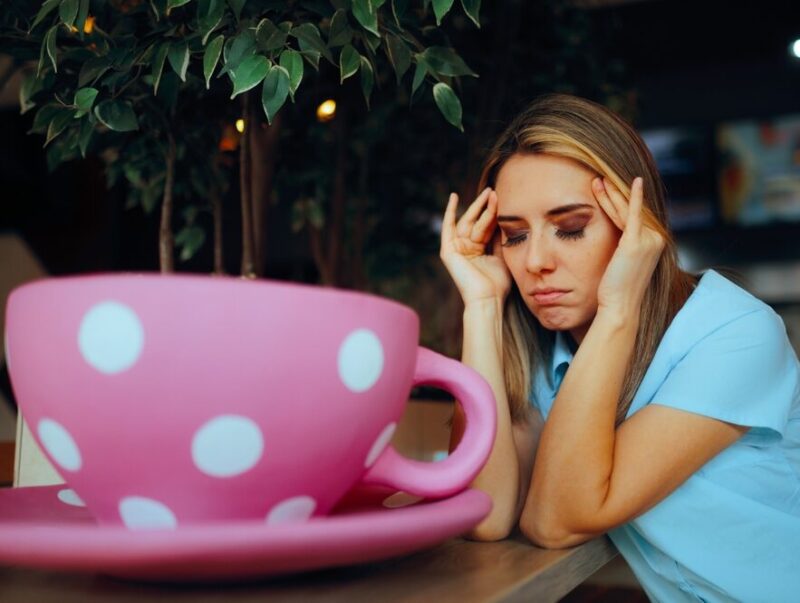Caffeine and migraine, what’s the connection?
While caffeine is often touted as a remedy for headaches because it can definitely help some, the relationship between caffeine and migraines is complex because caffeine can be a double-edged sword. Some patients get great pain relief, while caffeine’s effect can be problematic for others and actually cause headaches.
In this blog post, we will delve into the science behind caffeine’s effects on migraines, explore the potential benefits and drawbacks of using caffeine for migraine relief, and provide tips for managing caffeine intake to minimize the risk of triggering migraine attacks. Let me take another sip of my coffee and let’s get started!
Does caffeine help a migraine headache?
Can coffee help migraines and head pain? This is a common question patients often ask me in the office. The effectiveness of the use of caffeine in treating migraine headaches varies greatly among people. For some, a modest intake of caffeine can significantly lessen the severity of a migraine, acting as a natural pain reliever by narrowing the blood vessels and reducing inflammation around the brain. Interestingly, caffeine is actually a first line treatment for a headache called hypnic headache, and can also help tension type headache.
However, it’s crucial to approach caffeine use with caution, as it may exacerbate symptoms or lead to additional headaches in others. The key to leveraging caffeine as part of migraine management lies in understanding your body’s unique response to it. Experimenting with caffeine consumption during migraine attacks under the guidance of a healthcare professional can help identify whether it serves as a beneficial treatment in your specific case or if it might be contributing to the problem.
Why does caffeine help migraines?
Caffeine offers migraine relief through its biochemical interaction with the brain, particularly its influence on adenosine receptors. Adenosine, a neurotransmitter involved in pain signaling and blood vessel dilation, may play a role in migraine onset for some, along with other inflammatory chemicals released during an attack. When blood vessels in the brain dilate (widen), this triggers the small trigeminal nerves that are innervating and monitoring them. The trigeminal nerve signals go back to the brain and a migraine starts to intensify. This is a central piece to a migraine attack. Caffeine, by blocking these adenosine receptors, can prevent and reverse and reduce the adenosine-induced dilation of blood vessels, as well as inflammation.
So, the vasoconstrictive properties of caffeine can lead to a decrease in migraine intensity by causing the blood vessels to narrow back down. Furthermore, caffeine can enhance the effectiveness of common pain relievers.
It’s important for you to understand this mechanism to gauge how caffeine might fit into your broader migraine management strategy, always keeping in mind the delicate balance required to avoid potential caffeine-related side effects or exacerbation of symptoms.
Caffeine for migraine. How much caffeine is in migraine relief?
Navigating the precise amount of caffeine that can aid in migraine relief is a highly individualized journey. Research suggests that a moderate dosage, typically within the range of 100-200 mg, can offer significant relief for many individuals suffering from migraine attacks. This equates to about one to two average cups of coffee, depending on the brew strength.
However, it’s important to be mindful of the fine line between therapeutic and excessive use. Exceeding this moderate intake can inadvertently lead to caffeine withdrawal headache, similar to medication overuse headaches, a pitfall commonly encountered by those seeking migraine relief from taking excess pain relievers. This can also drive episodic migraine into more frequent headaches and eventually chronic migraine. By carefully monitoring and adjusting your caffeine consumption, you can harness its potential benefits while minimizing the risk of aggravating your symptoms.
Sensitivities vary, and what constitutes a relieving dose for one person may provoke adverse reactions in another, such as anxiety, insomnia, hypertension, or palpitations. Establishing a controlled, cautious method of caffeine intake helps you to determine how you react personally, as well as potential benefit from its analgesic properties while steering clear of the drawbacks associated with excessive use.
Can lack of caffeine cause headaches?
For those accustomed to regular caffeine consumption, a sudden reduction and going cold turkey can indeed trigger headaches, a phenomenon termed caffeine withdrawal headaches or caffeine headaches. Any amount of routine caffeine use, even a small amount of caffeine, can be involved in this problem. This type of headache arises as the body adjusts to the absence of caffeine, a substance it had grown to depend on for maintaining normal neurological function. This is a similar concept to medication overuse headache (rebound headaches) when excess pain reliever intake is cut back.
Caffeine’s role in blocking adenosine receptors means its sudden withdrawal leads to a rapid change in cerebral blood flow from blood vessel dilation, triggering headaches. These headaches can be full blown migraine attacks for some, or lower level tension headaches for others. In general, migraine patients tend to be more susceptible to this problem. Gradually tapering off caffeine, rather than an abrupt cessation, is recommended to lessen the likelihood and severity of these withdrawal symptoms, allowing the body’s natural adenosine receptors to recalibrate and function without caffeine’s influence.
Caffeine Content in Common Beverages
Navigating the landscape of caffeinated beverages is key to managing your migraine strategy effectively. A vast array of drinks contains caffeine, with the milligrams of caffeine varying significantly across different types. For instance, an average 8-ounce cup of coffee can offer anywhere from 95 to 200 mg of caffeine, while the same volume of tea might provide 14 to 70 mg, depending on the type and brewing time. A Starbucks blonde roast 20-oz venti serving has 475 mg of caffeine! Energy drinks, another popular source, can range dramatically, with some servings packing up to 300 mg of caffeine. Soda, too, contributes to your daily caffeine intake, typically containing less than 50 mg per 12 ounces but varying by brand and formula.
Understanding these differences is crucial for those integrating caffeine into their migraine management plan, as it empowers you to make informed decisions about your consumption, ensuring you stay within a therapeutic range that benefits your condition without inadvertently tipping the scales toward the adverse effects associated with excessive caffeine intake.
The Downside: Potential Side Effects of Caffeine Use
Embracing caffeine as a strategy for migraine relief warrants a careful consideration of its side effects, which can vary widely among individuals. While some may find a comforting respite in caffeine’s embrace, others may encounter unpleasant reactions that complicate its use. Caffeine speeds up the nervous system, so side effects commonly linked with caffeine intake include a noticeable increase in restlessness, anxiety and difficulty sleeping (insomnia), a faster heartbeat, palpitations, and stomach discomfort.
These reactions, though often mild, can become disruptive, especially in the context of trying to manage migraine symptoms. It is essential for those exploring caffeine as a remedy to remain vigilant, monitoring their body’s response to caffeine and adjusting their intake accordingly. Being mindful of these potential side effects is a critical step in crafting a balanced approach to migraine management that considers both the advantages and the limitations of caffeine as a therapeutic agent.
Caffeine as a Double-Edged Sword: Treating and Triggering Migraine Headaches Simultaneously
Caffeine acts as both a potential remedy and a risk. Its ability to constrict blood vessels and interact with brain chemistry means that, for some, it brings much-needed relief from the relentless grip of migraine pain. Yet, for others, the same properties can precipitate the very headaches they seek to avoid, and caffeine can actually be a migraine trigger.
The paradox lies in caffeine’s intricate effects on the brain’s vascular system and neurotransmitter activity, which can swing the pendulum towards relief or exacerbation based on individual sensitivities. This duality underscores the importance of carefully monitoring and adjusting caffeine consumption, being attuned to the body’s signals, and recognizing when caffeine may be doing more harm than good in the context of migraine control.
Navigating Caffeine Intake: Tips for Migraine Sufferers
If you are exploring caffeine as a part of your migraine management strategy, careful consideration of intake is essential. Begin by meticulously recording your caffeine consumption and observing any correlations with your migraine symptoms. Should you notice a pattern of caffeine withdrawal headaches (usually in the morning, before you’ve had your morning coffee), it’s advisable to gradually decrease your caffeine intake. Ensuring you’re well-hydrated (caffeine causes urination and dehydration) and maintaining other healthful practices, like consistent sleep patterns and exercise, can amplify the benefits of caffeine while minimizing potential downsides. Importantly, engaging with a healthcare provider or a migraine specialist can provide invaluable guidance. They can help tailor a treatment plan to safely incorporate caffeine, aligning it with your overall health goals and migraine management efforts.
What is the quickest way to get rid of a migraine? Can caffeine help?
Identifying the fastest method to alleviate a migraine is deeply personal and hinges on the unique characteristics of one’s symptoms and triggers. It’s unfortunately not a one size fits all and is usually a trial and error process. Beyond caffeine, which may provide headache relief of a migraine episode for some, a wide range of abortive headache medications exist. Given the diverse nature of migraines, seeking advice from your doctor is crucial. They can offer a customized approach tailored to your specific situation, ensuring the treatment plan is both effective and considerate of your overall health needs.
IF YOU HAVE HEADACHE, MIGRAINE, OR FACIAL PAIN AND ARE LOOKING FOR ANSWERS ON ANYTHING RELATED TO IT, A HEADACHE SPECIALIST IS HERE TO HELP, FOR FREE!
FIRST, LET’S DECIDE WHERE TO START:
IF YOU HAVE AN EXISTING HEADACHE, MIGRAINE, OR FACIAL PAIN DIAGNOSIS AND ARE LOOKING FOR THE LATEST INFORMATION, HOT TOPICS, AND TREATMENT TIPS, VISIT OUR FREE BLOG OF HOT TOPICS AND HEADACHE TIPS HERE. THIS IS WHERE I WRITE AND CONDENSE A BROAD VARIETY OF COMMON AND COMPLEX MIGRAINE AND HEADACHE RELATED TOPICS INTO THE IMPORTANT FACTS AND HIGHLIGHTS YOU NEED TO KNOW, ALONG WITH PROVIDING FIRST HAND CLINICAL EXPERIENCE FROM THE PERSPECTIVE OF A HEADACHE SPECIALIST.
IF YOU DON’T HAVE AN EXISTING HEADACHE, MIGRAINE, OR FACIAL PAIN DIAGNOSIS AND ARE LOOKING FOR POSSIBLE TYPES OF HEADACHES OR FACIAL PAINS BASED ON YOUR SYMPTOMS, USE THE FREE HEADACHE AND FACIAL PAIN SYMPTOM CHECKER TOOL DEVELOPED BY A HEADACHE SPECIALIST NEUROLOGIST HERE!
IF YOU HAVE AN EXISTING HEADACHE, MIGRAINE, OR FACIAL PAIN DIAGNOSIS AND ARE LOOKING FOR FURTHER EDUCATION AND SELF-RESEARCH ON YOUR DIAGNOSIS, VISIT OUR FREE EDUCATION CENTER HERE.




